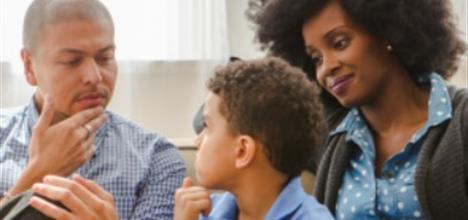Did you know that by age 2-4, children can internalize racial bias? Each of us has a responsibility to learn about our own role in being anti-racist and teaching our children to be anti-racist.
Talking to Children About Racial Bias - From the American Academy of Pediatrics (article below)
Also check out Five Ways to Reduce Racial Bias in Your Children - Greater Good Science Center at The University of California, Berkeley.
We are putting together additional resources that will be posted on our external resources page.
Mitchell School should be a place where everyone feels safe, welcome, and respected for who they are.
Talking to Children About Racial Bias

By: Ashaunta Anderson, MD, MPH, MSHS, FAAP & Jacqueline Dougé, MD, MPH, FAAP
Given the tragic and racially-charged current events, many parents are wrestling with their own feelings, the hopes they have for their children, and the difficulty of helping those children thrive in a world full of racial bias.
Parents may better face today's challenges with an understanding of how racial bias works in children, as well as strategies to help them deal with and react to racial differences.
How Do Children Learn Racial Bias?
Children learn about racial differences and racial bias from an early age and learn from their first teachers—their parents—how to deal with and react to these differences.
The process of learning racial bias is a lot like learning a new language (e.g., a child raised bilingual vs. a
child who starts learning Spanish in junior high). Biology determines a critical early learning period as well as a later window where learning is much harder.As early as 6 months, a baby's brain can notice race-based differences.
By ages 2 to 4, children can internalize racial bias.
By age 12, many children become set in their beliefs—giving parents a decade to mold the learning process, so that it decreases racial bias and improves cultural understanding.
But like language immersion, children exposed to society will gain fluency in racial bias even if their parents do nothing.
Strategies to Help Children Deal with Racial Bias
There are three strategies that parents can use to help their children deal with racial bias:
Talk to your children and acknowledge that racial differences and bias exist.
Confront your own bias and model how you want your children to respond to others who may be different than them.
Encourage your children to challenge racial stereotypes and racial bias by being kind and compassionate when interacting with people of all racial, ethnic, and cultural groups.
What Racism Felt Like to a 7-Year-Old: "You can't be Hans Solo...you're black." It hit me out of nowhere. I so was confused. I mean, my skin was certainly darker than anyone else in the group, but since when was that going to stop the game about space aliens? I assumed they sensed my confusion and offered me the role as Lando instead, because “…he looked more like you." It was the day that my mother explained racism to me. |
|---|
How Parents Can Confront Their Own Racial Bias
Parents must first confront their own biases, so that their example is consistent with messages of racial and ethnic tolerance.
Be a role model. Identify and correct your own racially biased thoughts, feelings, and actions. If you want your children to believe what you preach, you have to exhibit those behaviors as well. Your everyday comments and actions will say more than anything else.
Have a wide, culturally diverse social network. Encourage your children to have diverse circles of friends, as well. This lends itself to engagement in multicultural activities and experiences.
Travel and expose your children to other communities. This can help them understand that there is diversity in the world that might not be represented in the community that you live in.
- Get involved in your child's school, your place of worship, and politics. Parents who are involved in this way are better able to advocate for fair treatment of racially marginalized groups and raise awareness of race issues in other groups.
Tips for Talking About Racial Differences & Racism
Talking about race is not racist. It's OK—and important. From a young age, children may have questions about racial differences and parents must be prepared to answer them. But, it's important to keep your child's developmental readiness in mind.
For preschoolers: At this age, your child may begin to notice and point out differences in the people around you (i.e., at the grocery store, at the park, etc.). If your child asks about someone's skin tone, you might say, "Isn't it wonderful that we are all so different!" You can even hold your arm against theirs to show the differences in skin tones in your family.
For gradeschoolers: This is the age that is important to have open talks with your child about race, diversity, and racism. Discussing these topics will help your child see you as a trusted source of information on the topic, and he or she can come to you with any questions. Point out stereotypes and racial bias in media and books such as villains or "bad guys" in movies.
If your child makes comments or asks you questions about race based on school incidents or something they read or watched: Further the discussion with questions such as, "How do you feel about that?" and "Why do you think that?" This is also helpful if your child heard something insensitive or if your child experienced racial bias themselves. Before responding to his or her statement or question, figure out where it came from and what it means from his or her perspective. See Talking to Children About Tragedies & Other News Events for more information.
These conversations begin to lay the groundwork for your child to accept and respect everyone's differences and similarities. As children mature, the answers to questions will become more complex. These are moments to learn what your child understands or is struggling to understand about racial bias.
Remember:
To create a culture of inclusiveness, we all must look at and acknowledge our biases, so we can do something about the ones that are unfair or cause harm to others—like racial bias. Understanding the way people feel about and behave toward those outside their own group can help communities heal after a tragedy, as well as prevent future ones.
Additional Resources to Help Parents Address Racism & Discrimination:
Help Your Kids Find Books with Diverse Characters (Common Sense Media)
Apps and Games with Diverse Characters (Common Sense Media)
Beyond the Golden Rule. A Parent's Guide to Preventing and Responding to Prejudice (Tolerance.org)
A Conversation on Race (New York Times)
Racism and Its Impact on Child and Adolescent Health (AAP Policy Statement)
About Dr. Anderson:
 Ashaunta Anderson, MD, MPH, MSHS, FAAP is an assistant professor at the University of California, Riverside School of Medicine and a health policy researcher at RAND Corporation. Her research focuses on the impact of race and racism on child health. She is also a pediatrician and a published author of 50 Studies Every Pediatrician Should Know, a guide to the scientific evidence underlying everyday pediatric practice.
Ashaunta Anderson, MD, MPH, MSHS, FAAP is an assistant professor at the University of California, Riverside School of Medicine and a health policy researcher at RAND Corporation. Her research focuses on the impact of race and racism on child health. She is also a pediatrician and a published author of 50 Studies Every Pediatrician Should Know, a guide to the scientific evidence underlying everyday pediatric practice.
About Dr. Dougé:
 Jacqueline Dougé, MD, MPH, FAAP is the Child Health Medical Director at the Howard County Health Department. Her interests are health disparities, media, school health and the interaction of public health and pediatrics. Within the American Academy of Pediatrics, she co-chairs the Council on Community Pediatrics' Prevention and Public Health Special Interest Group. Her blog site is drjacquelinedouge.com.
Jacqueline Dougé, MD, MPH, FAAP is the Child Health Medical Director at the Howard County Health Department. Her interests are health disparities, media, school health and the interaction of public health and pediatrics. Within the American Academy of Pediatrics, she co-chairs the Council on Community Pediatrics' Prevention and Public Health Special Interest Group. Her blog site is drjacquelinedouge.com.
- Author
- Ashaunta Anderson, MD, MPH, MSHS, FAAP & Jacqueline Dougé, MD, MPH, FAAP
- Last Updated
- 6/25/2020
- Source
- American Academy of Pediatrics (Copyright © 2019)
